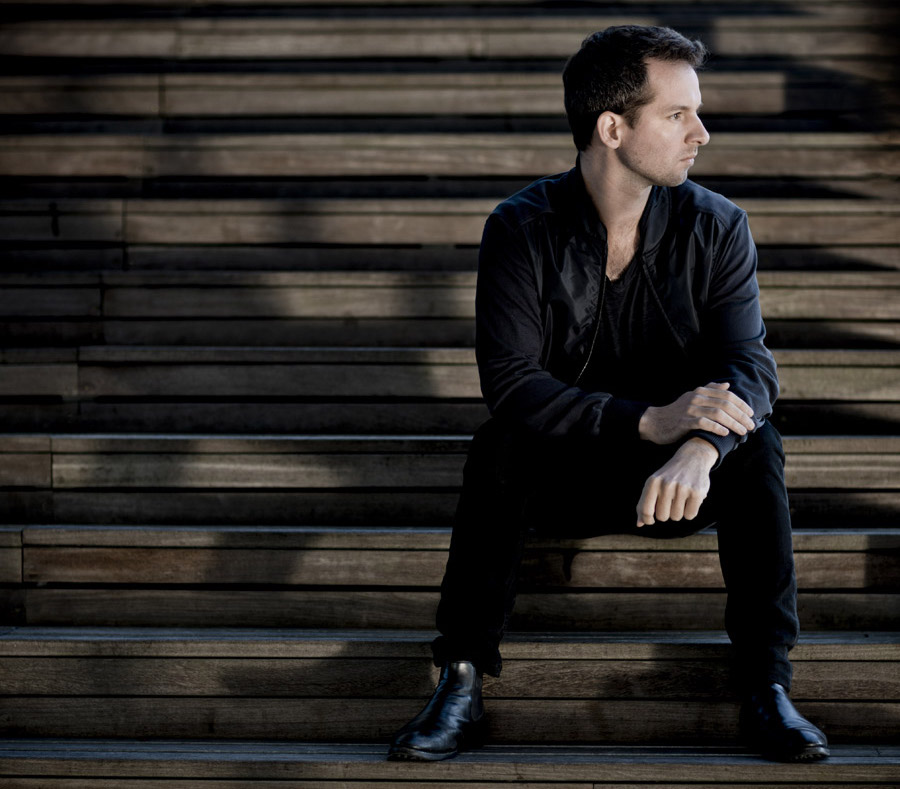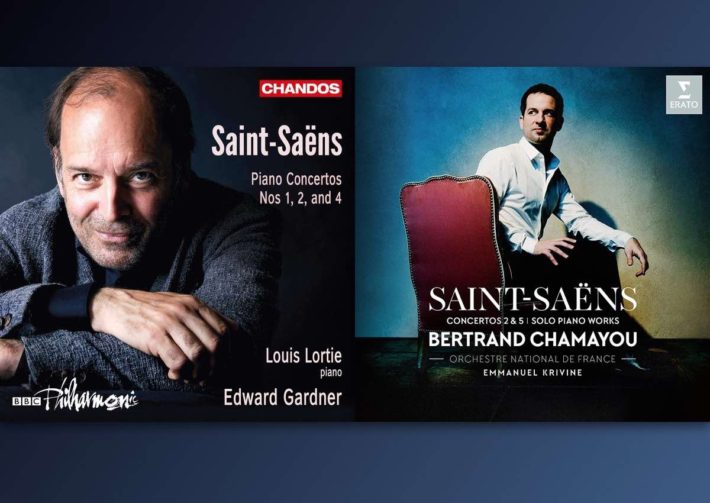Two new Saint-Saëns recordings from two top pianists are great news. Saint-Saëns’ piano concertos are arguably among the best in the romantic era with their ingenuity, sophisticated orchestration and internal dialogue between soloist and orchestra. If we take the two releases’ repertoire we get an almost complete cycle – Chamayou plays the Second and Fifth (“Egyptian”) Concertos, while Lortie plays the First, Second and Fourth. Chamayou fills the album with delightful solo pieces by the composer.
Lortie’s Saint-Saëns on Amazon
Chamayou’s Saint-Saëns on Amazon
Lortie’s entrance in the youthful first concerto is a bit matter-of-fact, and the introduction ends with scales not fully coordinated with the entrance of the orchestra. It’s an enthusiastic performance from soloist and orchestra alike, but missing in some charm and delicacy. Not knowing the piece, you might have thought it’s Liszt, so powerfully some segments are played. The slow movement, chilling in the famous Stephen Hough performance (Hyperion) is not matched here; The tempo seems rushed and the piano dry and under-peddled. The finale, on the other hand, is expertly and nicely done, with some moments that can bring a smile.
Comparing Two G Minors
The direct comparison between Lortie and Chamayou comes with the Second piano concerto; A longtime favourite among great pianists (and audiences), it comes in and out of fashion in concert halls and recording. It is well represented on record, and a new performance has some tough competition. Lortie starts the free-form opening forcefully, deliberately, and technically impressively. One would have preferred a bit more charm, more breathing-space and less force to the first subject and the Coda (hear the almost out-of-place crescendos coming from Lortie at 2:30, for instance). The pianissimos, on the other hand, sounds airless, plain. This is partly due to the recording quality; There are obvious volume and loudness meddling along the movements, and the general balance seems a bit off – The Strings area far back, the timpani is in-your-face close, and the piano at times hard-edged (Not to mention some odd noises coming from the orchestra (1:30). The recording doesn’t do justice to Lortie and the BBC orchestra under Gardner. There are some nicely done touches from Gardner, though, emphasizing some delicious woodwind accomplishment in the second and third movements. Here again, all parties involved are at their best in the finale, though Lortie can sound a bit hectic and heavy-handed in some sections where a playfulness finesse is called for.
Moving on to the Erato version, we enter a different sound world. Chamayou has a lyrical, mellow yet penetrating sound quality, very evident in some successful recordings he made for Erato, including the full Liszt’s Annees de Pelerinage, Franck’s orchestra and solo works, and a much-praised release of Debussy chamber works. Here he is accompanied by the French Orchestre National de Paris, under Emmanuel Krivine.

Chamayou handling of the first movement of the G Minor Concerto hits just the right balance between delicacy and an almost aristocratic weight. After a deep, glowing opening, his first theme introduction is quite moving (1:40), with some lean-sounding string accompaniment. In this version, the piano is closely and intimately recorded, without being overwhelming. The orchestra is balanced a little far behind the soloist. Nonetheless, the overall recording quality is much more successful than in the Chandos release. The orchestra, under the historically informed Krivine, sounds at time like a period-instrument orchestra, departing almost completely from vibrato. Contrary to Gardner, Krivine is less inclined to emphasize hidden contrapuntal jams from the orchestra sections, but his accompaniment is otherwise expertly executed – Listen for example to the long and difficult to sustain transition in the second movement, from 2:50 onwards. A joyful and sparkling third movement closes off an impressive, enjoyable performance of this concerto.
Imagenative Fills
Chandos fills their release with the Fourth Piano Concerto, an imaginative, original piece that’s hard to pull off. Here, as in the G Minor, though technically in command and in full perception of the form of this sophisticated piece, Lortie sounds rough, hurried, no-nonsense direct.
Chamayou once again has the edge with a very nicely done version of the fifth concerto (“Egyptian”). In the first movement, listen to the heartfelt treatment and the lovingly support from the Parisians in the second subject (2:00). In the oriental second movement, all parties are at their absolute best (This movement is the highlight of the entire album). One sometimes has to check the orchestral score to verify the colours Chamayou produces are not enforced by some other instrument (07:55). The third movement is given an enthusiastic performance that finishes off one of the best Saint-Saëns’ Fifth’s in recent memory, to be considered with another top-choice fifth, by Jean-Yves Thibaudet, L’Orchestre de la Suisse Romande & Charles Dutoit.
The solo fill-ups to the Chamayou release are a joy and an added bonus, with the Allegro Appassionato, Op. 70 and Valse Nonchalante, Op. 110 are another highlights.
Examining the competition, there are obviously endless versions of the Second Concerto, and some famous complete cycles, most notably the one by Stephen Hough on Hyperion. Unfortunately, at the time this review is written the British label does not offer its releases in classical music streaming services, only in the soon-to-be-obsolete iTunes music store. So although the most recommended full cycle, if streaming is your way of consuming music, the Pascal Rogé full cycle with Dutoit still sound terrific in all concertos. The second piano concerto will always be measured against Artur Rubinstein’s classic performance with the Philadelphia Orchestra under Ormandy (1969), which also accompanies another pianist in a fantastic performance – Philippe Entremont with his unforgettable version for the Second and Fourth Concertos. Emil Gilels’ version with André Cluytens is another reference point, although the recording does show its age (1954).
Chamayou performances are a nice addition to the Saint-Saëns discography, with the Fifth standing tall compared to other existing versions and a very nicely done Second indeed. There is no word if this is going to be a full cycle. Lortie’s version is vol. 1 of what is planned as a full cycle. Let’s hope he is presented better next time around.
Saint-Saëns: Piano Concertos Nos. 1, 2 & 4
Louis Lortie – Piano
BBC Philharmonic
Edward Gardner – Conductor
Erato / Warner Classics CD 0190295634261
Saint-Saëns – Piano Concertos No. 2 & 5
Bertrand Chamayou – Piano
Orchestre National de Paris
Emmanuel Krivine – Conductor
Erato CD CHAN 20031
Follow Us and Comment:
[wd_hustle id=”HustlePostEmbed” type=”embedded”]











